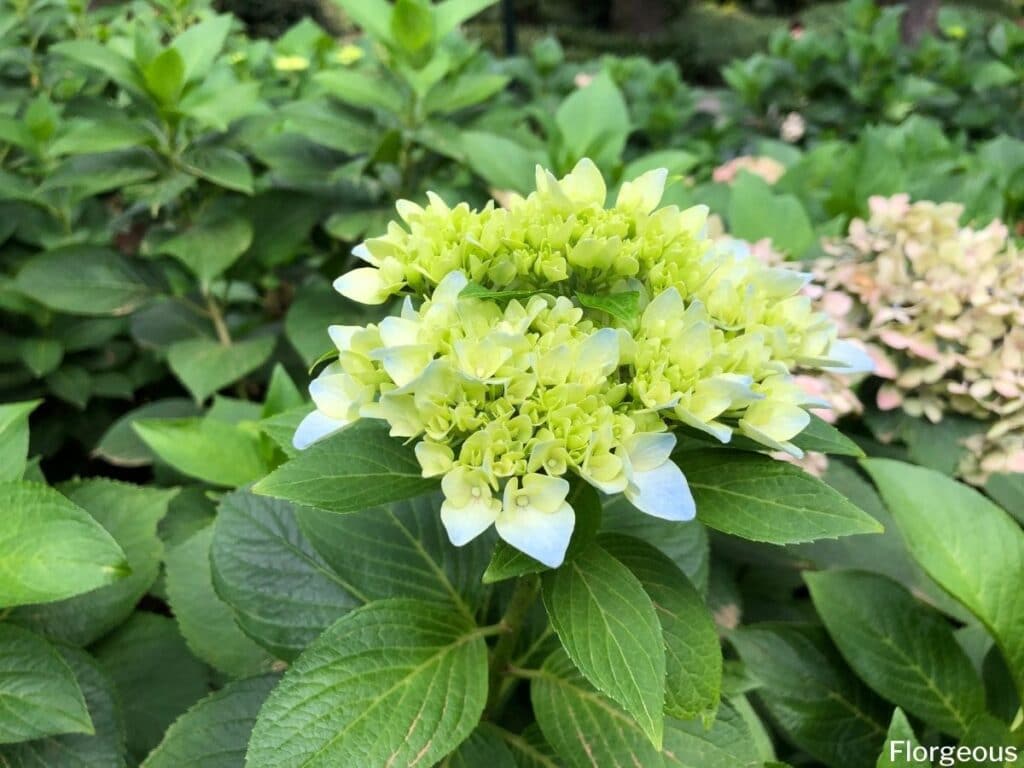If you are looking for some gorgeous hydrangea varieties to grow in your garden, consider these top species and cultivars.
Before learning how to grow hydrangea flowers, you need to know the type that suits your garden the best.
Here are the most commonly grown varieties of hydrangea you can grow.
Bigleaf or French Hydrangea (Hydrangea macrophylla) Cultivars
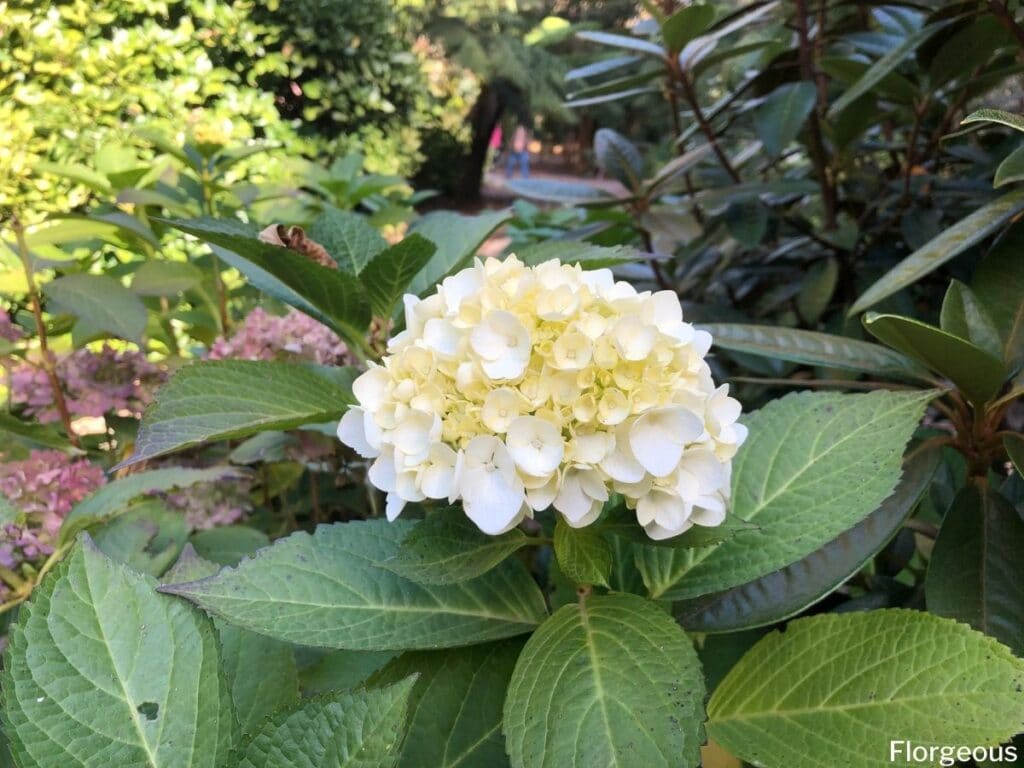
Hydrangea macrophylla is commonly known as the big leaf hydrangea or French hydrangea. It is also called Japanese hydrangea or snowball hydrangea.
These hydrangeas are famed both in gardens and floral shops as a gift plant, especially for Mother’s Day. They are also popular as this is the kind of hydrangeas with flower colors that can be modified from pink to blue or vice versa by adjusting the soil pH (5).
Mophead Hydrangea
Mophead Hydrangeas are some of the most recognizable types of hydrangeas, identified by their large, showy flower heads in colors such as blue, pink, and purple. The leaves are thick and shiny, sometimes shaped like hearts, with coarsely-toothed edges.
There are all kinds of mophead hydrangea cultivars you can grow, too.
‘Nikko Blue’
One of the most popular hydrangea cultivars, the ‘Nikko Blue’ hydrangeas gains recognition for its showy, large, rounded mophead flower clusters that are densely packed with deep blue florets.
‘All Summer Beauty’
While most hydrangeas flower for only a month or so, the ‘All Summer Beauty’ cultivar makes a difference. This hydrangea produces attractive blooms throughout the entire summer. It grows up to 3 to 4 feet upon full maturity.
The floriferous ‘All Summer Beauty’ hydrangeas have a mophead type of blue or pink flowers. This cultivar blooms on both old and new wood.
‘Forever Pink’
The ‘Forever Pink’ cultivar produces attractive mophead clusters of hot pink with red overtones florets. It reaches about 2.5 to 3 feet in height.
‘Let’s Dance Big Easy’
There are a variety of shrubs you can choose from in the ‘Let’s Dance’ collection. However, this reblooming selection is one of the best. It has large, vibrant flowers that change from a pinkish green to pink and often back to green! It is a great choice for people who enjoy cutting flowers for vases indoors.
Other ‘Let’s Dance’ cultivars include ‘Diva,’ ‘Moonlight,’ ‘Rave,’ ‘Starlight,’ ‘Rhythmic Blue,’ and more.
‘Cityline Berlin’
This shrub has thick, quilted foliage and large, full flowerheads. It’s just one of many different types of shrubs in the intensive ‘Cityline’ collection, with other options including ‘Mars,’ ‘Paris,’ ‘Rio,’ ‘Venice,’ and ‘Vienna.’
Lacecap Hydrangea
Lacecaps, H. macrophylla normalis, are identical to mop heads in just about every way. However, their blooms are shaped differently. These flowers have tiny buds in the center that are fertile, with the large, more showy blossoms around the outside edge of the plant being sterile flowers.
‘Red Star’
This bigleaf cultivar features lacecap clusters of red to purple-red flowers in alkaline soils. Mature plants reach about 3 to 5 feet both in height and spread.
Mountain Hydrangea
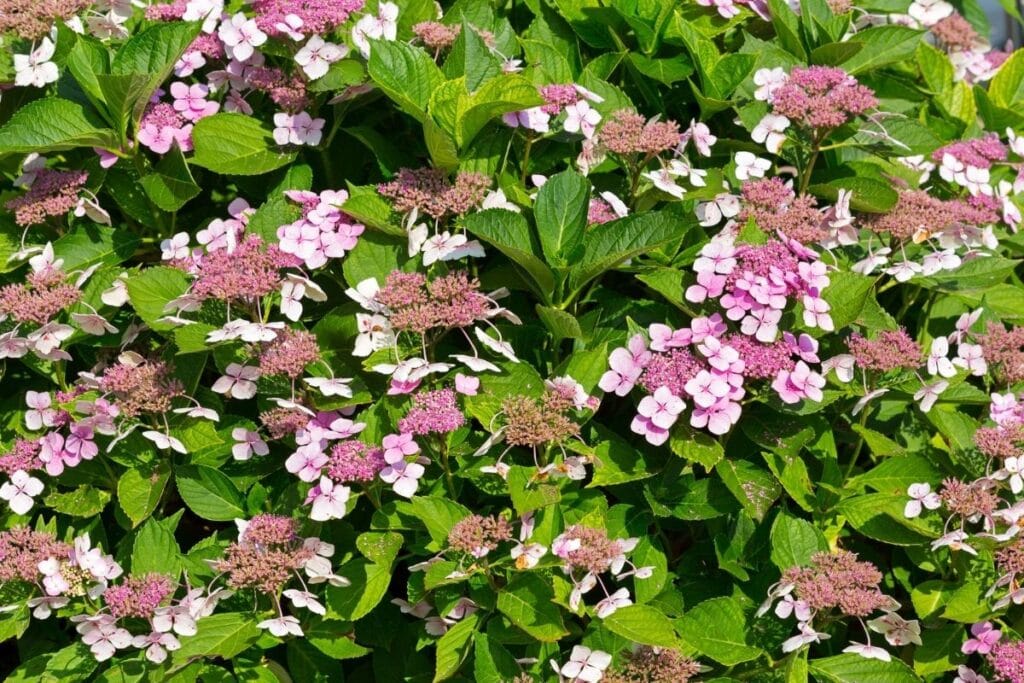
These shrubs, H. macrophylla ssp. Serrata or Hydrangea serrata, are among the least common of all bigleaf hydrangeas. They have small flowers so they aren’t as showstopping as other variants of the shrub. However, they are extremely hardy and can be grown in areas that experience the harshest winter weather.
‘Tuff Stuff’
One of the most popular types of mountain hydrangeas is ‘Tuff Stuff.’ It can be grown in partial shade and has attractive pink or purple blooms that can thrive even on chilly mountainsides. It reblooms, blooming first early in the summer on old wood, then again later in the season on new wood. It is one of the few kinds of hydrangeas that requires zero pruning.
‘Beni-Gaku’
This mountain hydrangea grows well in full to partial shade. Its flowers begin blue, then change to a pink or red. What you get one year in terms of flower color may not be exactly what you get the next!
‘Purple Tiers’
‘Purple Tears’ is another attractive variety that produces delicate tear-shaped petals in a vibrant purple shade.
Smooth Hydrangea (Hydrangea arborescens) Cultivars
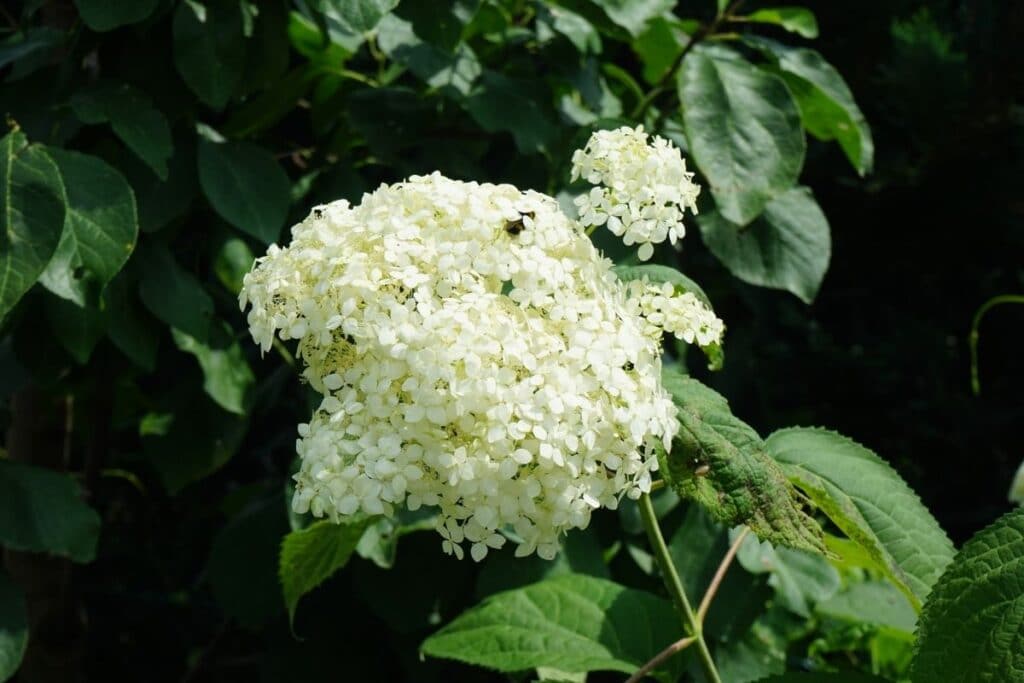
Hydrangea arborescens or smooth hydrangeas are also referred to as sevenbark or wild hydrangea. These shrubs are small to medium-sized, which grow about 3 to 5 feet in height and spread upon full maturity.
They are known for their long-lasting, large, rounded white flowers that bloom on the current season’s growth. The first blooms show a light green color but turn to cream or bright white as the flowers mature.
‘Annabelle’
The ‘Annabelle’ cultivar of smooth hydrangeas is a classic favorite among many gardeners and flower enthusiasts. This deciduous shrub blooms for up to two months and showcases massive, rounded flower clusters that are 10 to 14 inches wide.
‘Snow Hill’
The Hydrangea arborescens ‘Snow Hill’ is similar to the famed ‘Annabelle’ cultivar, only with smaller flower clusters that grow up to 8 inches wide. The plant reaches about 6 to 8 feet tall upon full maturity. It is also called the hills-of-snow hydrangea.
‘Invincibelle’
There are several types of ‘Invincibelle’ that you can grow, including ‘Ruby,’ ‘Wee White,’ ‘Mini Mauvette,’ ‘Limetta,’ and ‘Spirit.’
With attractive dark green foliage, this shrub has strong, sturdy stems that resist flopping and large, deeply colored blossoms in shades like pink and white. It has the ability to rebloom with gorgeous flowers that appear until the autumn months.
‘Incrediball’
‘Incrediball’ grows to about four feet tall and wide. Hardy in zones 3 to 9, this cultivar has blooms that can be as large as an impressive 12 inches wide. It has strong stems that won’t bend under the weight of the flowers (something that often happens with ‘Annabelle’ shrubs).
It blooms initially in the early summer with light green flowers that become white for the duration of the bloom period but back to green at the tail end of the season. It’s a great pick for attracting pollinators!
Panicle Hydrangea (Hydrangea paniculata) Cultivars
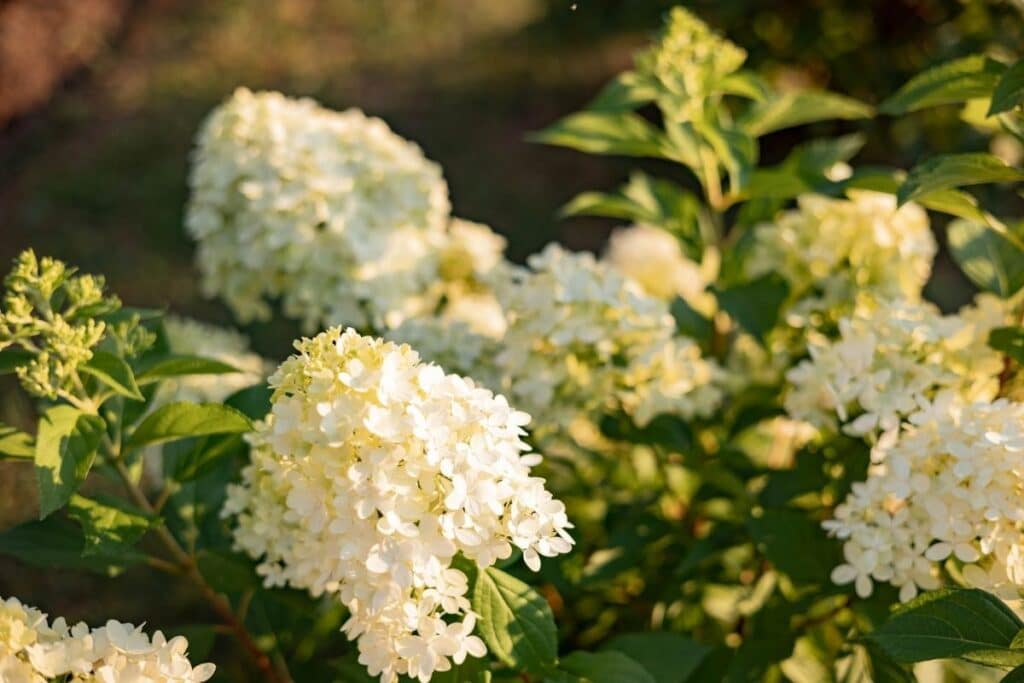
Hydrangea paniculata or panicle hydrangeas are native to eastern China and Japan. These hydrangea types are vigorous, upright, and fast-growing. Generally, mature plants reach about 8 to 15 feet tall and spread about 6 to 12 feet. Fascinating white blooms are the recognizing feature of this kind.
Panicles can be grown in zones 3 to 7 and are some of the most cold-hardy of all hydrangeas. They have recognizable leaves that grow up to six inches long and four inches wide, with sets of three growing from a stem-node and placed in whorls around a node. They can form trees, too, with central stems that are easy to prune into attractive trunks.
‘Grandiflora’
The ‘Grandiflora’ hydrangea is also called the PeeGee hydrangea or PG hydrangea. Mature plants reach about 10 to 25 feet in height and spread up to 16 feet. The blooms appear in white but slowly age to pink then fade to brown. The flower clusters are conical, typically 6 to 8 inches across.
‘Grandiflora Compacta’
The ‘Grandiflora Compacta’ cultivar is the compact version of the famous ‘Grandiflora’ hydrangeas. Mature plants reach about 4 to 6 feet in height and width, with white or cream flowers that slowly fade to pink as they mature.
‘Limelight’
This panicle hydrangea cultivar grows up to 8 feet upon maturity. It is native to China and Japan. The ‘Limelight’ hydrangeas have cone-shaped panicles of creamy white flowers that mature to chartreuse-lime then pink and eventually fade to beige.
Other cultivars of panicle hydrangeas include ‘Pink Diamond’, ‘Tardiva’, ‘Unique’, and ‘White Moth’.
‘Little Quick Fire’
This is one of the earliest flowering hydrangeas, with blossoms that appear about one month before any other cultivars. Its flower panicles begin white then become pale pink. It is hardy in zones 3 to 8.
‘Vanilla Strawberry’
‘Vanilla Strawberry’ has fluffy flowerheads loaded with sterile florets. These begin white but turn a bright pink in the middle of the summer, creating a delightful two-toned color effect. By the time fall arrives, the entirety of the flowerhead will be strawberry red – even the stems!
‘Bobo’
‘Bobo,’ hardy in zones 3 to 9, is a great pick for the gardener who thinks she just doesn’t have enough room for another shrub! This super-compact selection only grows to about three or four feet tall and wide. It’s covered in fluffy white flowers that become pink, then brown, just in time for winter.
‘Pink Diamond’
Last but not least is ‘Pink Diamond.’ This cultivar is known for its soft pink flower buds that become a deeper pink as the season wears on. It’s hardy in zones 4 to 9.
Oakleaf Hydrangea (Hydrangea quercifolia) Cultivars
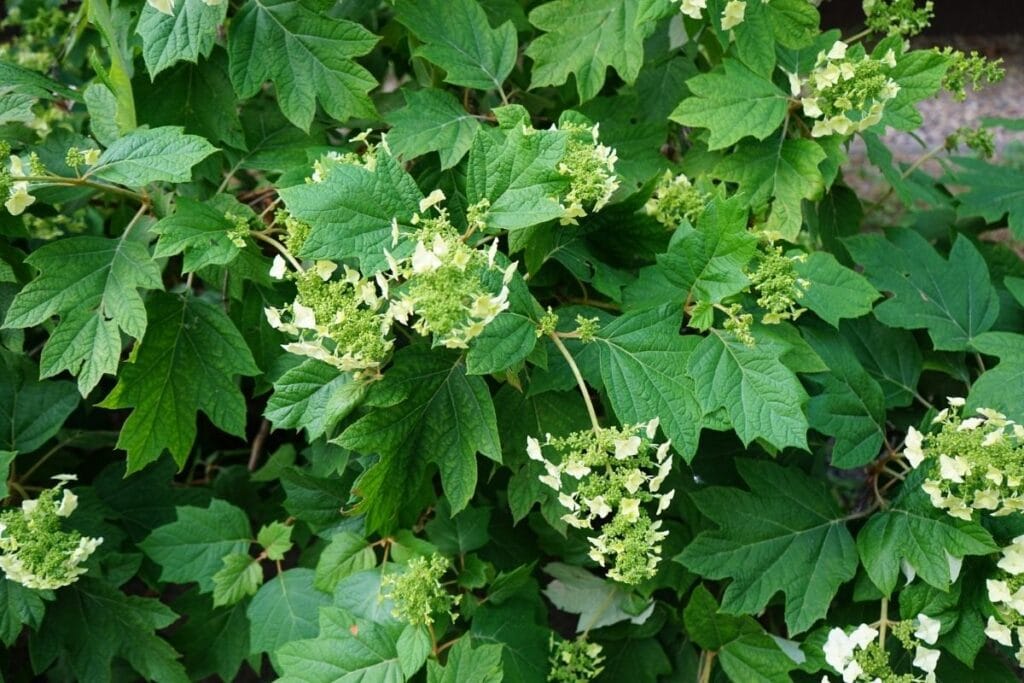
Hydrangea quercifolia, or otherwise referred to as the oakleaf hydrangea or oak-leaved hydrangea, is native to the southeastern part of the United States. This kind of hydrangea typically grows about 4 to 6 feet tall and blooms on old wood.
Harsh winter conditions could make Oakleaf hydrangeas lose substantial amounts of flower buds or die to the ground.
‘Alice’
‘Alice’ is one of the largest cultivars, growing up to 12’ tall by 12’ wide. Keep in mind of the size of this cultivar when choosing companion plants for hydrangea. It has large white flowers that become rosy pink, then tan, in the late summer.
‘Alison’
Not to be confused with ‘Alice,’ ‘Alison’ is less broad with inflorescences held up in a more upright fashion. It has large white flowers that become pink, then tan, by the end of summer.
‘Harmony’
Another large cultivar is ‘Harmony.’ Though not as large as ‘Alice,’ only growing to 10’ tall and wide, this plant has dense clusters of sterile double flower bunches. Its flowers are so dense, in fact, that their weight can cause branches to bend! It is somewhat difficult to find but undeniably beautiful.
‘Gatsby Moon’
This specimen grows to about 8’ tall by 8’ wide. It has full, tightly packed double flowers that age from a delicate white to a vibrant green as the season goes on.
‘Little Honey’
A compact variety, this hydrangea has attractive and unique golden-yellow foliage in the early spring. This becomes the characteristic green late in the summer before becoming red in the fall. It loves a bit of morning sun and afternoon shade!
‘Munchkin’
This cultivar grows to just three feet tall and has a compact form and dense growing habit that makes it perfect for the small residential landscape. Its flowers start off white but gradually turn a pale pink in color.
‘Rubber Slippers’
Another oakleaf cultivar to consider is ‘Ruby Slippers.’ This semi-dwarf cultivar has a mounding growth habit and is a hybrid of ‘Pee Wee’ and ‘Snow Queen,’ two other popular varieties we’ll tell you more about below. Its flowers open white but gradually become pink and then deep red as the summer wears on.
‘Pee Wee’
At just five feet tall and four feet wide, this cultivar holds its own. It has dark burgundy or purple leaves that fall off the plant entirely late in the season. It’s upright and compact, with blossoms that become tan in the late summer.
‘Snow Queen’
The ‘Snow Queen’ hydrangeas showcase stunning blooms of large and upright conical flower heads with white florets, as well as lobed, oak-like leaves that turn bronze-purple to red in the fall. Mature plants reach up to 6 feet tall and spread up to 8 feet.
‘Queen of Hearts’
‘Queen of Hearts’ grows to about 6.5’ tall and was developed by the U.S. National Arboretum’s shrub breeding program. It’s a hybrid of ‘Pee Wee’ and ‘Snow Queen,’ with flowers that open white but slowly become a darker pink over time.
‘Snowflake’
The ‘Snowflake’ oakleaf hydrangea features double-flowered blooms with cone-shaped white flower clusters that turn rosy pink as they mature. The oak-like leaves turn bronze-purple to red in the fall. Mature ‘Snowflake’ hydrangeas grow about 6 to 10 feet in height and spread.
Other recognized oakleaf hydrangea cultivars include ‘Alice’, ‘Pee Wee’, and ‘Sike’s Dwarf’.
Climbing Hydrangea (Hydrangea petiolaris) Cultivars
Hydrangea petiolaris plants are unique because they don’t grow like shrubs but instead like vines. Native to Asia and found in places like Korea, Japan, and Siberia, these plants can grow in zones 4 to 8.
Though they are still somewhat difficult to find, they are growing more popular for their ability to grow upward instead of outward – and for their attractive blooms. Some can grow up to 80 feet long!
FAQs
What is the most common hydrangea color?
Hydrangeas come in a variety of colors, but the most common colors are blue, pink, and white.
What is the prettiest hydrangea?
As for the prettiest hydrangea, beauty is subjective and depends on personal preference. Some popular and highly regarded varieties include ‘Endless Summer’, ‘Limelight’, ‘Annabelle’, and ‘Penny Mac’. These varieties are admired for their lush blooms and vibrant colors.
What is the most unique hydrangea?
When it comes to the most unique hydrangea, one could argue for varieties such as ‘Fire Light’, ‘Twist-n-Shout’, or ‘Pistachio’, which offer distinctive features such as unique bloom shapes, color variations, or foliage characteristics.
Which hydrangea smells the best?
Regarding fragrance, hydrangeas are not typically known for their scent. However, there are some varieties that have a subtle fragrance. For example, the ‘Sweet Summer’ series, particularly ‘Sweet Summer Bride’, is known for its light, sweet fragrance.
Final words
If you grow a combination of these types of hydrangeas, you will definitely end up with an absolutely amazing garden with colorful flowers. Either you buy small plants to grow, or if you have old plants that produce seeds, learning how to plant hydrangea seeds would be beneficial.
*image by sasimoto&cristaldream&Smlyubov/depositphotos

